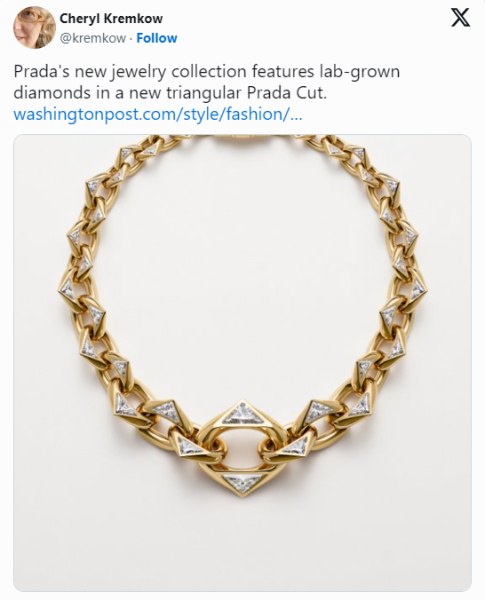A year after launching its fine jewelry collection, the Italian luxury brand is adding lab-grown diamonds to the mix.
New York—Prada has introduced a line of lab-grown diamond jewelry, making it one of the few high-end luxury brands to utilize the stones so far.
The Italian fashion powerhouse has been experimenting with its fine jewelry offerings after welcoming Timothy Iwata, Cartier’s former global innovation officer, two years ago as its first jewelry director.
The brand debuted its first collection of fine jewelry last October using all recycled gold.
In a recent interview with the Washington Post, Iwata shared the thinking behind the new addition.
“Lab-grown diamonds are not just about replicating what’s possible for nature in a short period of time … It’s actually pushing the boundaries of, one, the cut [of a stone], and two, the idea of luxury material. It’s not just about customizing some existing material. We actually grow that material for the client,” he said.
“You don’t get your own crocodile grown to become your bag.”
Prada joins two LVMH-owned brands in using lab-grown diamonds.
Fred recently debuted a group of five lab-grown blue diamonds, including one weighing 8.88 carats, and TAG Heuer has used lab-grown diamonds in a few of its watches, including the Carrera model with pink diamonds introduced at Watches & Wonders Geneva earlier this year.
The new Prada collection will feature “Prada-cut” diamonds, said Iwata, a triangle shape that mimics the brand’s logo.

The designs include heart-shaped earrings set with the signature triangular diamonds, wraparound snake rings with diamond heads, and a chunky gold chain set with diamonds.
Prada is owned by Prada Group, which also has Miu Miu in its portfolio.
Prada did not respond to National Jeweler’s request for more information, like pricing and availability.
The collection is not yet available on Prada’s website.
The hope is that this new collection will appeal to younger consumers, posited Washington Post style writer Rachel Tashjian.
“If the tennis bracelet was once the entry point for high-end jewelry, younger consumers, Iwata said, are more interested in pieces that frame the face, such as earrings and necklaces, because they spend much more time socializing online,” wrote Tashjian.

